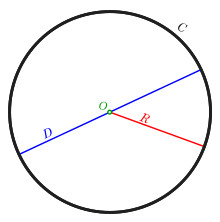Circumference is the distance around the edge of a circle or ellipse. It’s the perimeter of these curved shapes, just like the outline of a polygon. When you trace your finger around the rim of a cup, you’re following its circumference.
Circles and Pi: A Perfect Pair
The circumference of a circle is intimately linked with the famous mathematical constant pi (π). This relationship is so fundamental that π is defined as the ratio of a circle’s circumference to its diameter. In mathematical terms:
π = C / d
Where C is the circumference and d is the diameter. This means we can easily calculate a circle’s circumference if we know its diameter or radius:
C = πd = 2πr
This simple formula hides a world of complexity. π is an irrational number, meaning its decimal representation never ends and never settles into a repeating pattern. It’s a number that’s fascinated mathematicians for millennia.
Archimedes: The Ancient Pi Hunter
Back in 250 BCE, the Greek mathematician Archimedes tackled the challenge of calculating π. He didn’t have modern calculators or computers, so he got creative. Archimedes inscribed and circumscribed regular 96-sided polygons around a circle. By calculating their perimeters, he showed that π was between 3 10/71 and 3 1/7. This method of approximating π using polygons was used for centuries, with each generation using more sides for greater accuracy.
Ellipses: When Circles Get Stretched
While circles are straightforward, ellipses are trickier. There’s no simple formula for an ellipse’s circumference using just its axes lengths. But mathematicians have developed approximations. One, credited to Euler in 1773, estimates the circumference of an ellipse with semi-major axis a and semi-minor axis b as:
C ≈ π(a + b)(1 + (3h)/(10 + √(4 – 3h)))
Where h = (a – b)^2 / (a + b)^2
This formula balances accuracy and simplicity, making it useful for many practical applications.
Circumference in the Real World
Circumference isn’t just a mathematical concept – it’s crucial in many real-world applications. Engineers use it to design wheels, pipes, and circular structures. Astronomers use it to measure celestial bodies. Even in everyday life, you might use circumference to figure out how much ribbon you need to wrap around a circular gift box.
Understanding circumference opens up a world of circular reasoning – in the best possible way. It’s a concept that connects the abstract world of mathematics with the physical world around us, from the coins in your pocket to the planets in our solar system.
Citations:
In geometry, the circumference (from Latin circumferens, meaning "carrying around") is the perimeter of a circle or ellipse. The circumference is the arc length of the circle, as if it were opened up and straightened out to a line segment. More generally, the perimeter is the curve length around any closed figure. Circumference may also refer to the circle itself, that is, the locus corresponding to the edge of a disk. The circumference of a sphere is the circumference, or length, of any one of its great circles.


